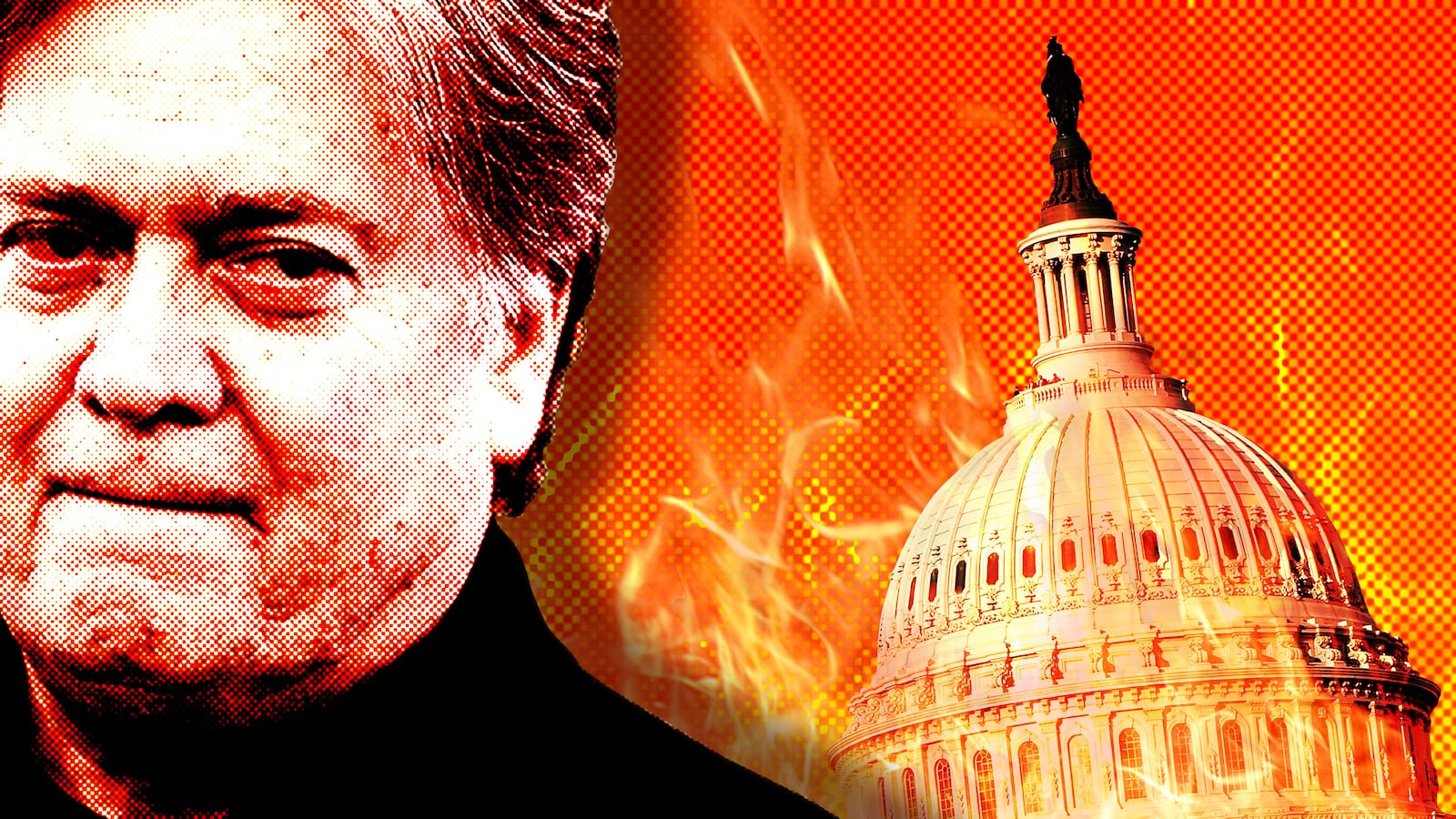Last August I wrote an article for the The Daily Beast [that has now gone viral] about a strange encounter I had with Steve Bannon at a party on Nov. 12, 2013. Bannon, whom I had never met, came up to me and informed me that he was a “Leninist” who wanted to bring down the establishment including the Republican and Democratic Parties. Back then, he was organizing and speaking for the Tea Party, and his sights were set on winning Congressional races. They were the vehicle through which he hoped his ideas would take root and that by winning races the Tea Party activists would set the stage for a future populist transformation.
Bannon has certainly come far. Not only is he a senior adviser to the president at the White House, he is hiring many of his former staff at Breitbart.com to join him. He has been given an unprecedented seat on the Principles Committee of The National Security Council (never before given to a political adviser by any administration, Democrat or Republican). Not content with this, Bannon has created a counter group to the NSC in his office, called the Strategic Initiatives Group. The NSC’s “stature, independence and influence,” as Julie Smith and Derek Chollet write in Foreign Policy, has been even more eroded. As they put it, “Bannon and his team have been increasing their public profiles on foreign policy issues in recent days,” which may be an understatement.
It is no wonder that Bannon is sarcastically being referred to by many commentators as “President Bannon.” This past week, it was Bannon- not the president- who got the cover story in Time which called him “the Second Most Powerful Man in the World.” Because of his importance in the Trump administration, there is great interest in finding out what he believes, and what motivates him.
The answer is to be found in a speech Bannon delivered in New York City to an outdoor rally to the New York Tea Party on April 15, 2010. Here he is angry, and inflames the rowdy crowd with his attacks on the “world financial system.” Bannon attributes the financial collapse to “the financial elites and the American political class.” They took care of themselves, he tells the crowd, and let everyone else suffer, as government took over the financial industry, the auto industry and the health system. He refers to the “ticking time bomb” of mortgage defaults, and he calls the situation an “existential threat” to the nation, a “true crisis” that threatens the nation’s sovereignty. “Our beloved country is an addict,” he says, led by the “pushers on Wall Street.” Then he holds up a copy of The New York Times which he calls the paper “of the liberal elite,” while he describes The New York Post as the paper of the people. The Tea Party, Bannon says, are the people who fight our wars, pay our taxes, work in civic organizations—“the beating heart of the greatest nation on earth.”
It is the end of his speech, however, that is most important. After blasting Anderson Cooper and CNN, he concludes with words that somehow have escaped all the commentators who have been writing on Bannon:
"It doesn’t take a weatherman to see which way the wind blows, and the winds blow off the high plains of this country, through the prairie and lights a fire that will burn all the way to Washington in November."
Although his audience may not have gotten the reference, he was saying that he and the Tea Party are revolutionaries who want to bring down the system. Bannon took the phrase from a verse of Bob Dylan’s Subterranean Homesick Blues, which was used by the self-proclaimed revolutionary young people in the late ’60s and ’70s who created first the Weathermen, and then the Weather Underground terrorist group from the detritus of Students for a Democratic Society. Their publication in which they spread their ideas was named Prairie Fire, and four years before he spoke, the Weather Underground’s leaders—Bill Ayers, Bernardine Dohrn, and Jeff Jones published their writings for a new generation, in the book Sing a Battle Song, a compendium of the group’s revolutionary arguments.
These revolutionary New Leftists’ goal was to use bombing and guerrilla warfare tactics to bring down our democratic capitalist system, to smash the state and create a revolution in the United States. Clearly Bannon is consciously revealing that he sees the Tea Party as the equivalent of a new revolutionary movement, that will play the same role as did the Weather Underground by organizing to destroy the old order.
Recent articles, including one in The Washington Post by Frances Stead Sellers and David A. Fahrenthold, and another one by Steve Reilly and Brad Heath in USA Today, have presented his views from his take on Islam, which he believes we are at war with, to his belief that there is a crisis of national sovereignty which is being threatened by global elites, which necessitates “strong nationalist movements” being developed both here and abroad.
Bannon famously believes that “we’re at war,” not only with jihadists and Islam around the world, but at home with the press—the real opposition party—and the entire American left-wing. But to understand just what Bannon’s actual world view is, one must look at other speeches he gave to different Tea Party groups. The most recent was this past August, in the heat of Trumps’ campaign which Bannon had joined, before it was becoming apparent that Trump would win the White House.
Anyone who thinks Bannon is not smart will think differently after hearing his performance. In much of his speech he sounds like Bernie Sanders. He talks about how working-class and middle-class women who formed the Tea Party know how prices for groceries have gone up, and about the debt their children have incurred for going to college. He talks about the new Generation Zero, as he calls today’s young generation, that knows no history and hence buy into the illusions of Occupy Wall Street.
Here, Bannon’s anger is directed at the cultural, financial, industrial and political elite in America. His concern is for the enraged middle-class, who sees “socialism for the poor and the very wealthy,” while middle-class people are “paying for their own children’s destruction.” He notes how the bankers and the people at Goldman-Sachs, where he once worked, made money on the backs of regular people, who lost their homes and saw their incomes decline. [One wonders what he thinks of Stephen Mnuchin, who made a killing from owning One West Bank, that foreclosed on delinquent homeowners, and then evicted them from their houses and profited from their losses.] “There is no depression,” he says, “in Georgetown” and “in East Hampton.” The people he speaks to, he tells them, “are the last line of defense” for saving America.
Bannon distains Republicans and conservatives who, he thinks, got everything wrong by attacking the Tea Party. He names people he says he has “great respect for,” including conservative pundits Charles Krauthammer and David Frum. He and the Tea Party, Bannon emphasizes are not “homophobic, nativist” and “racist,” but simply people trying to save the country. Referring to America as a center-right nation, Bannon attacks the large national debt and out of control federal spending which keeps expanding it. And of course, he has no patience for the Occupy Wall Street movement who know very little about real life and how it works.
Bannon, of course, put it most succinctly in his much-discussed speech at the Vatican in 2014. It is here that he talked about “the global war against Islamic fascism” that must be waged, about crony capitalism that in the Marxist sense treats people as commodities, and where he praises the “entrepreneurial spirit… that can flow back to working-class and middle-class people.” If you put aside his nationalist solution, this is quite like the arguments made by most leftists and socialists.
What is different is that Bannon clearly favors an alliance with the new right-wing authoritarian and populist parties in Europe, with Le Pen’s National Front in France, Neil Farage’s UKIP in Britain, and Geert Wilders’ Party of Freedom in the Netherlands, as well as other similar ones throughout the continent. He states, attacking crony capitalism, that… "all the upside goes to the hedge funds and the investment banks, and to the crony capitalist with stock increases and bonus increases. And their downside is limited," because the banks will be saved and bailed out by middle-class taxpayers.
Now that he is in the White House, Bannon seeks to use the Trump presidency and administration as the vehicle to fulfill the very revolutionary goals he has sought since 2008. Referring to the movement he is helping build as revolution- “and this is a revolution,” Bannon emphasized in the Vatican speech, his end goal is to create “a new center-right populist movement.” That seems at first glance to be a benign goal, since other conservatives and centrists also favor it. But Bannon’s version is different- when he says “center-right” he means a new nationalist, anti-immigrant movement quite different from that favored by many conservatives and centrists. That alone, he believes will produce the revolutionary outcome he seeks.
Whether or not he will succeed remains to be seen.






